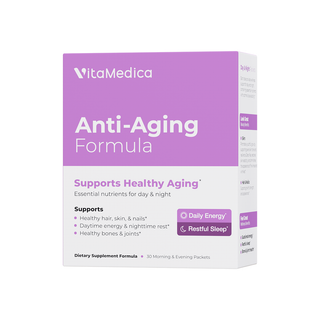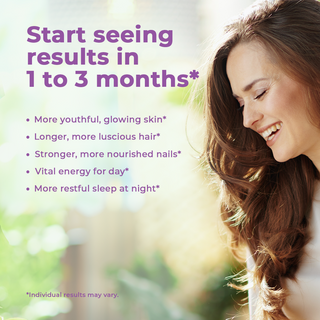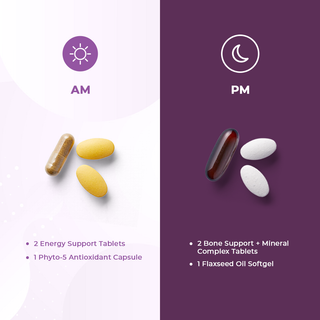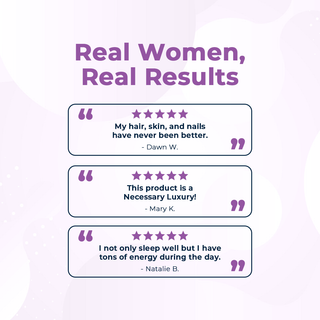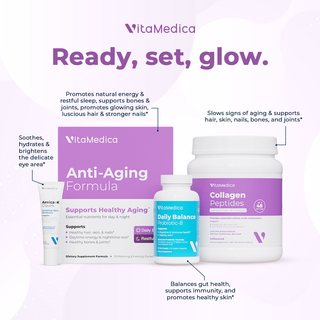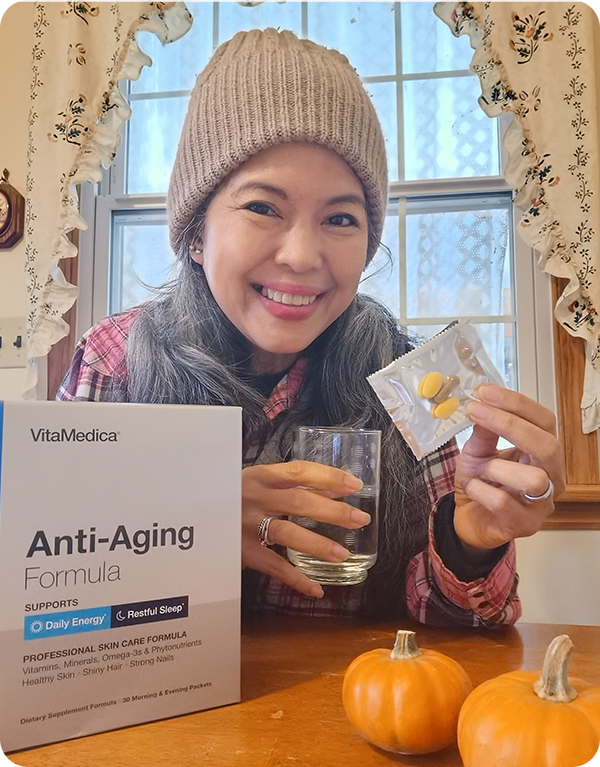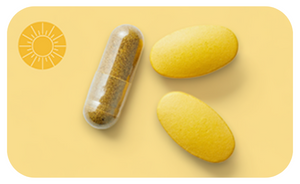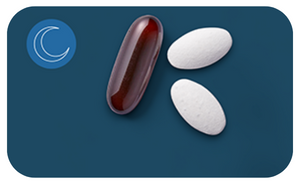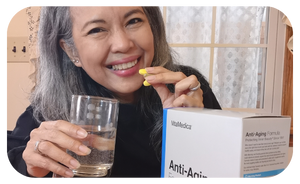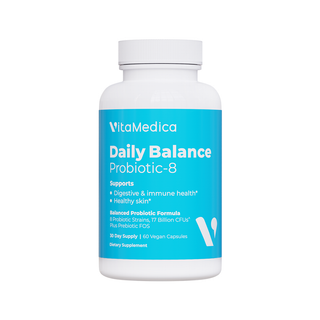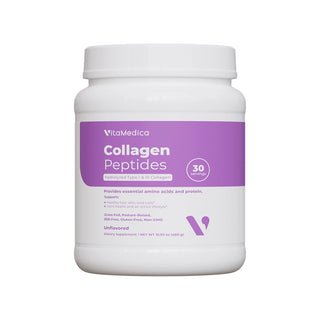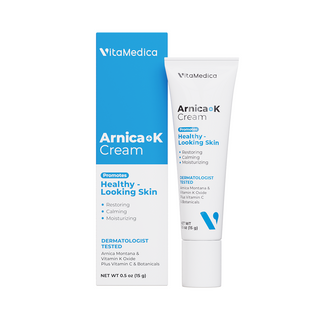Get glowing with Anti-Aging Formula, physician-formulated anti-aging supplements to help you feel your best while diminishing signs of aging and improving the appearance of hair, skin, and nails. Start seeing results in 1-3 months.**
Feel Great:
Natural Energy
- Support energy levels throughout the day with essential nutrients to help you stay alert and manage stress.*
Restful Sleep
- Get your beauty rest. Promotes relaxation and restful sleep. Wind down in the evenings with nutrients formulated to promote relaxation and restful sleep, enhance dreaming, and restore brain neurochemicals.*
Bone & Joint Support
- Calcium, magnesium, vitamins D and K, and boron support bone and joint health, strength, and density, while betatene carotenoids and vitamin E enhance nutrient absorption.*
Look Great:
Anti-Aging Supplement
- The best supplements for glowing skin and anti-aging.
- Defend against skin-aging free radicals with superfood nutrients, promote skin elasticity and collagen production with vitamins and minerals, and diminish the look of fine lines and wrinkles with omega-3 fatty acids.*
Healthy Hair, Skin, & Nails
- See younger-looking skin, stronger nails with faster growth, and thicker, more luscious hair. This anti-aging supplement with vitamins for crepey skin supports skin hydration and thickness for healthy, supple-looking skin, and wards off signs of aging with antioxidants.*
- Formulated with biotin, vitamins for beauty (A, C & E), and nourishing minerals calcium, magnesium, selenium, copper, and zinc.*
**Individual results may vary.
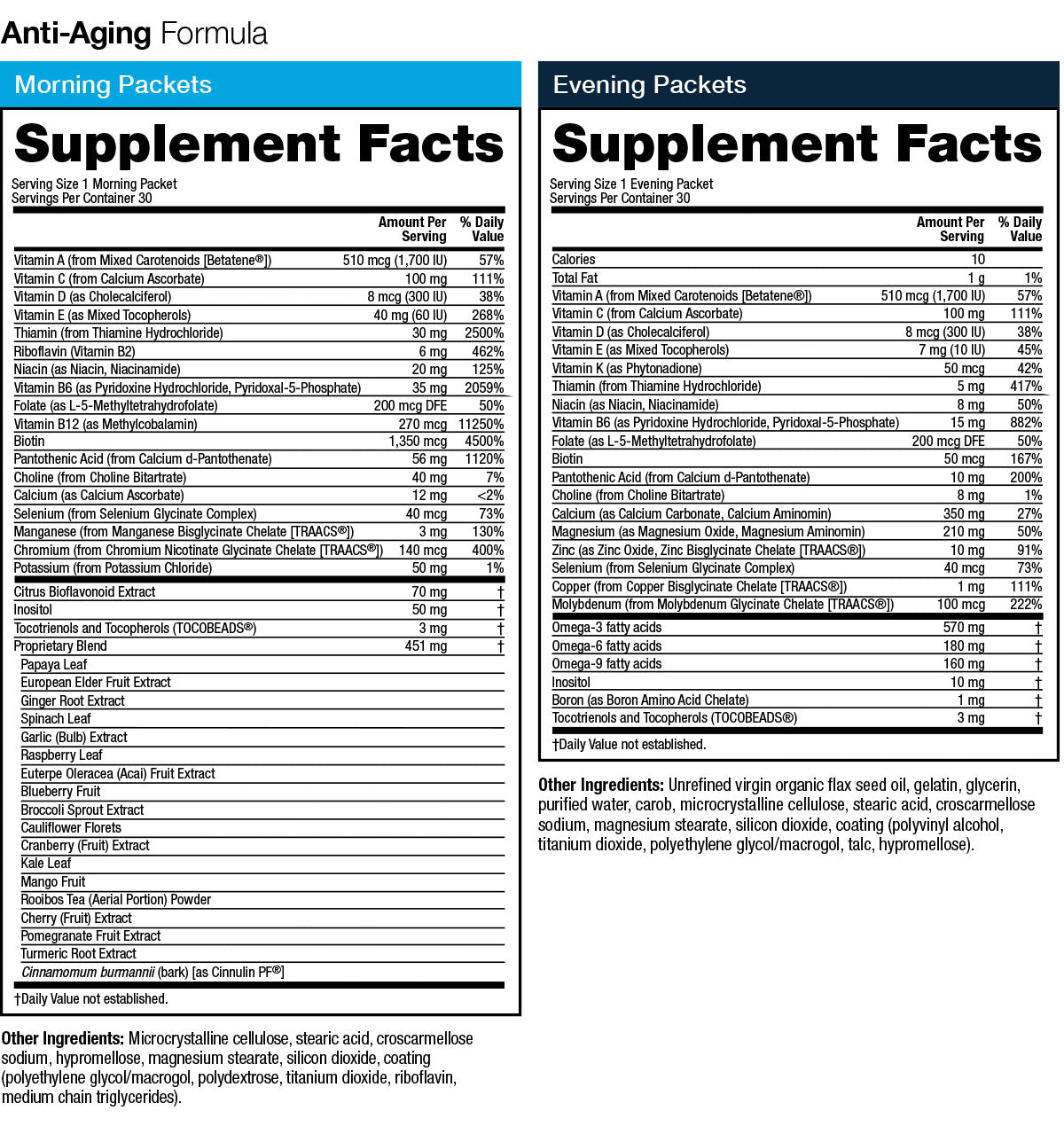
Morning Packet Directions: As a dietary supplement, take one morning packet daily with breakfast or lunch. Each individual is unique and nutritional requirements may vary.
Evening Packet Directions: As a dietary supplement, take one evening packet daily with dinner or before bedtime. Each individual is unique and nutritional requirements may vary.
WARNINGS: KEEP OUT OF REACH OF CHILDREN. If you are diabetic, pregnant or breast-feeding, seek advice of your physician before using this product. ENERGY SUPPORT and BONE SUPPORT contain niacin, which may cause a temporary redness of the skin and flushing. BONE SUPPORT contains vitamin K and is contraindicated in patients taking blood thinners.
Not manufactured with wheat, milk, soy, egg, fish, shellfish, peanuts or tree nut ingredients. Produced in a GMP-certified facility that processes other ingredients containing these allergens.
Storage: Store in a cool, dry place.
What is the primary benefit of using the Anti-Aging Formula?
Anti-Aging Formula provides key vitamins, minerals, Omega-3s and phytonutrients in convenient daily packets to promote a youthful complexion, shiny hair, and strong nails.
What makes VitaMedica’s Anti-Aging Formula unique?
Quality – the ingredients, dosing, and formula are put together in such a manner thereby ensuring optimal absorption and utilization by the body– coupled with convenience. Like many things in life, you get what you pay for and the same is true with nutritional supplements. Anti-Aging Formula is provided morning and evening packets. The use of time, or chronotherapy, provides the right nutrients at the right time of day. In addition, divided doses ensure optimal absorption of the water-soluble vitamins. The formulation contains natural vitamins, which provide better absorption than their synthetic counterparts. The supplement also contains the right balance of vitamins & minerals to eliminate the worry about whether you’re taking the right amount, or in the right combination. And, the product contains chelated minerals for maximal absorption. The supplement does not contain any preservatives or dyes which can cause an allergic reaction in some individuals.
Can the Anti-Aging Formula help me with my hair, skin & nails?
Yes. Key nutrients that support healthy hair include the B-complex. Anti-Aging Formula is formulated with biotin and pantothenic acid plus the other B-vitamins. Key nutrients that support healthy skin include vitamins A, C, and E plus the minerals selenium, zinc and copper. These vitamins and minerals which are included in Anti-Aging Formula, play an important role in the development of collagen and elastin – two proteins that give skin structure and resilience. The Omega-3s in Anti-Aging Formula support the natural balance of oils in your hair, skin, and nails. Phytonutrients in the formula help to provide natural protection from the sun’s harmful rays.
What supplements comprise the Anti-Aging Formula morning and evening packets?
The morning packet contains 2 tablets of VitaMedica’s Energy Support plus 1 capsule of VitaMedica’s Phyto-5. The evening packet contains 2 tablets of VitaMedica’s Bone Support plus 1 softgel of VitaMedica’s Organic Flax Seed Oil.
Why is the Anti-Aging Formula provided in morning and evening packets?
To enhance absorption and to provide the right nutrients at the right time of day. The morning formulation contains nutrients needed to stay energized and alert, with stable blood glucose levels during the day (e.g., B-complex, chromium), and cope with stress. Conversely, the evening formulation contains nutrients needed during the evening to promote rest and relaxation, enhance dreaming during sleep and restore brain neuro-chemicals (e.g., calcium and other minerals). Another reason for taking supplements in the morning and evening is that the water-soluble vitamins (vitamin C and the B-Complex) are better absorbed if taken in divided doses. These nutrients are not stored in the tissues like the fat-soluble vitamins.
I normally take a “one-a-day” type multi-vitamin & mineral. Why can’t VitaMedica’s Anti-Aging Formula provide everything in just one tablet?
While the concept of taking one tablet a day is ideal it is difficult to provide all the essential micronutrients that the body requires in one tablet. This is particularly a challenge for bulk vitamins such as calcium which take up a lot of room in a tablet. In addition, this method of delivery is not ideal for the water-soluble vitamins (B-complex and vitamin C) which are not stored in the body and therefore need to be replenished throughout the day. VitaMedica’s Anti-Aging Formula also includes the Omega-3s from flaxseed oil plus phytonutrients which provide benefits beyond a normal “one-a-day” type multi-vitamin & mineral.
The Supplement Facts Panel indicates that the source of vitamin A is from Betatene®. What is Betatene?
Although most people have heard of beta-carotene, a number of other carotenes exist including alpha-carotene, gamma-carotene, lycopene, zeaxanthin, and lutein. While not all of the carotenes convert to vitamin A, all provide excellent antioxidant protective benefits. Most supplements contain just beta-carotene and in many cases, the source is not natural but is synthesized. Betatene is a naturally occurring blend of carotenes, which includes beta-carotene, alpha-carotene, cryptoxanthin, zeaxanthin, and lutein. Betatene is derived from D. salina algae and is grown on the world’s largest cultivated algae farm, located in Whyalla, Australia.
The Anti-Aging Formula is formulated with 200 mg of vitamin C. Shouldn’t I be getting more of this nutrient daily?
Not necessarily. Vitamin C is a water-soluble vitamin that has an excellent safety track record. While most individuals are accustomed to taking 500, 1,000 or even 1,500 mg of vitamin C daily, our bodies do not require this amount for optimal health and wellness. At high doses, the risk of toxicity with vitamin C is very low because unlike their fat-soluble counterpart, the body does not store the excess. But, taking amounts over 1,000 mg can cause gastrointestinal upset in some people. Supplementing the diet with 200 mg per day of vitamin C to support general health and wellness is sufficient for most individuals. However, boosting vitamin C intake during periods of stress (injury, sickness or surgery) is recommended which is why VitaMedica’s Clinical Support for Surgery supplement (taken during the peri-operative period) is formulated with 750 mg of this nutrient.
The Supplements Facts Panel refers to two sources of Vitamin E (tocopherols and tocotrienols). Why are both forms provided in the formula?
To provide both vitamin E activity and antioxidant protective benefits. Vitamin E refers to a family of eight compounds: four tocopherols and four tocotrienols. In each family, the members are named alpha, beta, gamma, and delta. Normally in foods that contain vitamin E, each of the family members is present. However, in most supplements and topical skin care products, only one member is provided, typically alpha-tocopherol. While alpha-tocopherol provides the highest level of vitamin E activity, some of the other members like delta-tocotrienol and gamma-tocotrienol have more potent antioxidant effects. Including all members of the vitamin E family in a formula is more expensive but the finished product provides a broader range of benefits.
Some of the B-vitamins in the Multi-Vitamin & Mineral are well above the Recommended Daily Allowance (RDA). Why are the amounts this high and are they safe?
The RDAs or Recommended Daily Allowances are nutritional guidelines that were originally established in 1941 by the National Academy of Sciences. Since their establishment, many studies have been conducted regarding the use of vitamins, minerals, herbs and other nutritional supplements. The Guidelines reflect the minimum requirements to achieve health but do not take into consideration sex, age, weight, activity levels and other dietary factors. For this reason, the RDAs are viewed as being deficient particularly as it relates to key antioxidants such as vitamin E and vitamin C. Instead, Optimal Dosages have been established by industry leaders and better reflect requirements based on recent findings from research and longitudinal studies. The Anti-Aging Formula has been formulated to contain optimal amounts of each ingredient to ensure safety and efficacy. In particular, the B-Complex has an excellent safety profile even at much higher intakes than the RDA.
Anti-Aging Formula is formulated with 500 mg of calcium. Shouldn’t I be getting closer to 1,000-1,500 mg of calcium per day?
Yes. While adult women should obtain about 1,000-1,500 mg of calcium per day in their diet, it is difficult to obtain this amount just from supplements. The best way to obtain this amount of calcium is by obtaining some from a supplement like VitaMedica’s Anti-Aging Formula and by eating foods high in calcium such as low-fat dairy products, some dark green leafy vegetables, salmon, and peanuts.
What are phytonutrients?
Phytonutrients are found in fruits, vegetables, nuts, teas, and spices. While over 4,000 phytonutrients have been identified, these plant chemicals can be classified into five major groups: carotenoids (e.g., beta-carotene, lutein, lycopene), phenolics (ellagic acid, quercetin, luteolin, epicatechin, hesperidin, malvidin, genistein), alkaloids, nitrogen-containing compounds and organosulfur compounds (indoles, glucosinolates). Phytonutrients are responsible for giving plants their distinctive color. Although colorful, plant pigments are designed to protect the plant from the sun’s harmful rays. Importantly, these plant chemicals protect the plant from bacteria, viruses, parasites, and insects. When consumed, phytochemicals confer a wide range of health benefits to humans including antioxidant, anti-inflammatory, and anti-cancer.
What role do oxidation and free-radicals play in the aging process?
Oxidants are toxic byproducts of cells as they metabolize oxygen to create energy. Oxidants include free-radicals, which are atoms with at least one unpaired electron, making them highly reactive. Because of the way free-radicals interact with other cells in an attempt to stabilize, they often cause a cascading effect that ultimately results in damage to other cells. Free-radicals form as a by-product of normal cellular activity. In addition, exposure to ultraviolet light, pollution, and cigarette smoke also contribute to free-radical formation. Even diet and stress can affect the level of free-radical formation in the body. This is important because excessive free-radical formation can damage cells and tissue. Researchers also believe that free-radical damage contributes to aging.
What are antioxidants and what role do they play in health?
Antioxidants restore the body’s balance and inhibit cell damage due to oxidative stress. Fortunately, the body has a number of mechanisms in place to neutralize free-radicals. Three enzymes are particularly important in this process and include superoxide dismutase, catalase, and glutathione peroxidase. These enzymes act as antioxidants by bonding with the unpaired electron, thereby neutralizing its potentially damaging effect on the body. One of the most important roles that the phytonutrients found in plants have is to provide antioxidant protective benefits.
Why is Anti-Aging Formula formulated with flaxseed oil and not fish oil?
Both flaxseed oil and fish oil are excellent sources of Omega-3 fatty acids. For this reason, we recommend both as part of a healthy, well-balanced diet. While VitaMedica’s Super EPA/DHA fish oil has been molecularly distilled to ensure no fishy aftertaste, some people are reluctant to take a fish oil supplement. To ensure that our Anti-Aging Formula appealed to a wide range of patients, we opted to include just our organic Flax Seed Oil supplement. For those wishing to obtain all of the cardiovascular, brain health and anti-inflammatory benefits of fish oil, our Super EPA/DHA Fish oil can be purchased separately.
I normally take a multi along with a calcium, vitamin E, and vitamin C supplement. Do I need to continue taking these supplements while taking the Anti-Aging Formula?
In most cases, it is not necessary. One of the benefits of using VitaMedica’s Anti-Aging Formula is that it provides all of the key vitamins and minerals necessary to obtain optimal health and wellness. For this reason, it allows many patients to simplify their nutritional supplement regimen by eliminating many of the additional supplements they have been taking. The only exception is women who have been instructed by their doctor to take additional calcium to prevent the progression of osteoporosis.
Anti-Aging Formula does not contain any iron. I thought iron was important; why is this mineral not included?
Women of child-bearing age need to make sure that they obtain an adequate amount of iron. Iron is important for growth, promoting resistance to disease and preventing fatigue. However, iron-containing supplements should only be taken after lab tests show an iron deficiency. This is important because iron-overload is twice as common as iron deficiency. Importantly, iron supplements should be taken separately from a multi-vitamin & mineral formulation because iron interferes with the absorption of other nutrients.
I noticed that the morning tablets are yellow and the evening tablets are white. What is the reason for this and are these artificial colorants?
The morning formulation is coated by the B-vitamin riboflavin; the evening formulation is coated with the mineral zinc. Both are natural colorants and do not contain any artificial dyes or colorants.
Anti-Aging Formula
- Unit price
- /per
Restore your youthful glow with anti-aging supplements physician-formulated to boost collagen production and diminish signs of aging. See age-defying results in just 1 to 3 months:
- Fewer fine lines*
- Healthy hair, skin, & nails*
- Boosted energy & restful sleep*
Adding product to your cart
Get glowing with Anti-Aging Formula, physician-formulated anti-aging supplements to help you feel your best while diminishing signs of aging and improving the appearance of hair, skin, and nails. Start seeing results in 1-3 months.**
Feel Great:
Natural Energy
- Support energy levels throughout the day with essential nutrients to help you stay alert and manage stress.*
Restful Sleep
- Get your beauty rest. Promotes relaxation and restful sleep. Wind down in the evenings with nutrients formulated to promote relaxation and restful sleep, enhance dreaming, and restore brain neurochemicals.*
Bone & Joint Support
- Calcium, magnesium, vitamins D and K, and boron support bone and joint health, strength, and density, while betatene carotenoids and vitamin E enhance nutrient absorption.*
Look Great:
Anti-Aging Supplement
- The best supplements for glowing skin and anti-aging.
- Defend against skin-aging free radicals with superfood nutrients, promote skin elasticity and collagen production with vitamins and minerals, and diminish the look of fine lines and wrinkles with omega-3 fatty acids.*
Healthy Hair, Skin, & Nails
- See younger-looking skin, stronger nails with faster growth, and thicker, more luscious hair. This anti-aging supplement with vitamins for crepey skin supports skin hydration and thickness for healthy, supple-looking skin, and wards off signs of aging with antioxidants.*
- Formulated with biotin, vitamins for beauty (A, C & E), and nourishing minerals calcium, magnesium, selenium, copper, and zinc.*
**Individual results may vary.

Morning Packet Directions: As a dietary supplement, take one morning packet daily with breakfast or lunch. Each individual is unique and nutritional requirements may vary.
Evening Packet Directions: As a dietary supplement, take one evening packet daily with dinner or before bedtime. Each individual is unique and nutritional requirements may vary.
WARNINGS: KEEP OUT OF REACH OF CHILDREN. If you are diabetic, pregnant or breast-feeding, seek advice of your physician before using this product. ENERGY SUPPORT and BONE SUPPORT contain niacin, which may cause a temporary redness of the skin and flushing. BONE SUPPORT contains vitamin K and is contraindicated in patients taking blood thinners.
Not manufactured with wheat, milk, soy, egg, fish, shellfish, peanuts or tree nut ingredients. Produced in a GMP-certified facility that processes other ingredients containing these allergens.
Storage: Store in a cool, dry place.
What is the primary benefit of using the Anti-Aging Formula?
Anti-Aging Formula provides key vitamins, minerals, Omega-3s and phytonutrients in convenient daily packets to promote a youthful complexion, shiny hair, and strong nails.
What makes VitaMedica’s Anti-Aging Formula unique?
Quality – the ingredients, dosing, and formula are put together in such a manner thereby ensuring optimal absorption and utilization by the body– coupled with convenience. Like many things in life, you get what you pay for and the same is true with nutritional supplements. Anti-Aging Formula is provided morning and evening packets. The use of time, or chronotherapy, provides the right nutrients at the right time of day. In addition, divided doses ensure optimal absorption of the water-soluble vitamins. The formulation contains natural vitamins, which provide better absorption than their synthetic counterparts. The supplement also contains the right balance of vitamins & minerals to eliminate the worry about whether you’re taking the right amount, or in the right combination. And, the product contains chelated minerals for maximal absorption. The supplement does not contain any preservatives or dyes which can cause an allergic reaction in some individuals.
Can the Anti-Aging Formula help me with my hair, skin & nails?
Yes. Key nutrients that support healthy hair include the B-complex. Anti-Aging Formula is formulated with biotin and pantothenic acid plus the other B-vitamins. Key nutrients that support healthy skin include vitamins A, C, and E plus the minerals selenium, zinc and copper. These vitamins and minerals which are included in Anti-Aging Formula, play an important role in the development of collagen and elastin – two proteins that give skin structure and resilience. The Omega-3s in Anti-Aging Formula support the natural balance of oils in your hair, skin, and nails. Phytonutrients in the formula help to provide natural protection from the sun’s harmful rays.
What supplements comprise the Anti-Aging Formula morning and evening packets?
The morning packet contains 2 tablets of VitaMedica’s Energy Support plus 1 capsule of VitaMedica’s Phyto-5. The evening packet contains 2 tablets of VitaMedica’s Bone Support plus 1 softgel of VitaMedica’s Organic Flax Seed Oil.
Why is the Anti-Aging Formula provided in morning and evening packets?
To enhance absorption and to provide the right nutrients at the right time of day. The morning formulation contains nutrients needed to stay energized and alert, with stable blood glucose levels during the day (e.g., B-complex, chromium), and cope with stress. Conversely, the evening formulation contains nutrients needed during the evening to promote rest and relaxation, enhance dreaming during sleep and restore brain neuro-chemicals (e.g., calcium and other minerals). Another reason for taking supplements in the morning and evening is that the water-soluble vitamins (vitamin C and the B-Complex) are better absorbed if taken in divided doses. These nutrients are not stored in the tissues like the fat-soluble vitamins.
I normally take a “one-a-day” type multi-vitamin & mineral. Why can’t VitaMedica’s Anti-Aging Formula provide everything in just one tablet?
While the concept of taking one tablet a day is ideal it is difficult to provide all the essential micronutrients that the body requires in one tablet. This is particularly a challenge for bulk vitamins such as calcium which take up a lot of room in a tablet. In addition, this method of delivery is not ideal for the water-soluble vitamins (B-complex and vitamin C) which are not stored in the body and therefore need to be replenished throughout the day. VitaMedica’s Anti-Aging Formula also includes the Omega-3s from flaxseed oil plus phytonutrients which provide benefits beyond a normal “one-a-day” type multi-vitamin & mineral.
The Supplement Facts Panel indicates that the source of vitamin A is from Betatene®. What is Betatene?
Although most people have heard of beta-carotene, a number of other carotenes exist including alpha-carotene, gamma-carotene, lycopene, zeaxanthin, and lutein. While not all of the carotenes convert to vitamin A, all provide excellent antioxidant protective benefits. Most supplements contain just beta-carotene and in many cases, the source is not natural but is synthesized. Betatene is a naturally occurring blend of carotenes, which includes beta-carotene, alpha-carotene, cryptoxanthin, zeaxanthin, and lutein. Betatene is derived from D. salina algae and is grown on the world’s largest cultivated algae farm, located in Whyalla, Australia.
The Anti-Aging Formula is formulated with 200 mg of vitamin C. Shouldn’t I be getting more of this nutrient daily?
Not necessarily. Vitamin C is a water-soluble vitamin that has an excellent safety track record. While most individuals are accustomed to taking 500, 1,000 or even 1,500 mg of vitamin C daily, our bodies do not require this amount for optimal health and wellness. At high doses, the risk of toxicity with vitamin C is very low because unlike their fat-soluble counterpart, the body does not store the excess. But, taking amounts over 1,000 mg can cause gastrointestinal upset in some people. Supplementing the diet with 200 mg per day of vitamin C to support general health and wellness is sufficient for most individuals. However, boosting vitamin C intake during periods of stress (injury, sickness or surgery) is recommended which is why VitaMedica’s Clinical Support for Surgery supplement (taken during the peri-operative period) is formulated with 750 mg of this nutrient.
The Supplements Facts Panel refers to two sources of Vitamin E (tocopherols and tocotrienols). Why are both forms provided in the formula?
To provide both vitamin E activity and antioxidant protective benefits. Vitamin E refers to a family of eight compounds: four tocopherols and four tocotrienols. In each family, the members are named alpha, beta, gamma, and delta. Normally in foods that contain vitamin E, each of the family members is present. However, in most supplements and topical skin care products, only one member is provided, typically alpha-tocopherol. While alpha-tocopherol provides the highest level of vitamin E activity, some of the other members like delta-tocotrienol and gamma-tocotrienol have more potent antioxidant effects. Including all members of the vitamin E family in a formula is more expensive but the finished product provides a broader range of benefits.
Some of the B-vitamins in the Multi-Vitamin & Mineral are well above the Recommended Daily Allowance (RDA). Why are the amounts this high and are they safe?
The RDAs or Recommended Daily Allowances are nutritional guidelines that were originally established in 1941 by the National Academy of Sciences. Since their establishment, many studies have been conducted regarding the use of vitamins, minerals, herbs and other nutritional supplements. The Guidelines reflect the minimum requirements to achieve health but do not take into consideration sex, age, weight, activity levels and other dietary factors. For this reason, the RDAs are viewed as being deficient particularly as it relates to key antioxidants such as vitamin E and vitamin C. Instead, Optimal Dosages have been established by industry leaders and better reflect requirements based on recent findings from research and longitudinal studies. The Anti-Aging Formula has been formulated to contain optimal amounts of each ingredient to ensure safety and efficacy. In particular, the B-Complex has an excellent safety profile even at much higher intakes than the RDA.
Anti-Aging Formula is formulated with 500 mg of calcium. Shouldn’t I be getting closer to 1,000-1,500 mg of calcium per day?
Yes. While adult women should obtain about 1,000-1,500 mg of calcium per day in their diet, it is difficult to obtain this amount just from supplements. The best way to obtain this amount of calcium is by obtaining some from a supplement like VitaMedica’s Anti-Aging Formula and by eating foods high in calcium such as low-fat dairy products, some dark green leafy vegetables, salmon, and peanuts.
What are phytonutrients?
Phytonutrients are found in fruits, vegetables, nuts, teas, and spices. While over 4,000 phytonutrients have been identified, these plant chemicals can be classified into five major groups: carotenoids (e.g., beta-carotene, lutein, lycopene), phenolics (ellagic acid, quercetin, luteolin, epicatechin, hesperidin, malvidin, genistein), alkaloids, nitrogen-containing compounds and organosulfur compounds (indoles, glucosinolates). Phytonutrients are responsible for giving plants their distinctive color. Although colorful, plant pigments are designed to protect the plant from the sun’s harmful rays. Importantly, these plant chemicals protect the plant from bacteria, viruses, parasites, and insects. When consumed, phytochemicals confer a wide range of health benefits to humans including antioxidant, anti-inflammatory, and anti-cancer.
What role do oxidation and free-radicals play in the aging process?
Oxidants are toxic byproducts of cells as they metabolize oxygen to create energy. Oxidants include free-radicals, which are atoms with at least one unpaired electron, making them highly reactive. Because of the way free-radicals interact with other cells in an attempt to stabilize, they often cause a cascading effect that ultimately results in damage to other cells. Free-radicals form as a by-product of normal cellular activity. In addition, exposure to ultraviolet light, pollution, and cigarette smoke also contribute to free-radical formation. Even diet and stress can affect the level of free-radical formation in the body. This is important because excessive free-radical formation can damage cells and tissue. Researchers also believe that free-radical damage contributes to aging.
What are antioxidants and what role do they play in health?
Antioxidants restore the body’s balance and inhibit cell damage due to oxidative stress. Fortunately, the body has a number of mechanisms in place to neutralize free-radicals. Three enzymes are particularly important in this process and include superoxide dismutase, catalase, and glutathione peroxidase. These enzymes act as antioxidants by bonding with the unpaired electron, thereby neutralizing its potentially damaging effect on the body. One of the most important roles that the phytonutrients found in plants have is to provide antioxidant protective benefits.
Why is Anti-Aging Formula formulated with flaxseed oil and not fish oil?
Both flaxseed oil and fish oil are excellent sources of Omega-3 fatty acids. For this reason, we recommend both as part of a healthy, well-balanced diet. While VitaMedica’s Super EPA/DHA fish oil has been molecularly distilled to ensure no fishy aftertaste, some people are reluctant to take a fish oil supplement. To ensure that our Anti-Aging Formula appealed to a wide range of patients, we opted to include just our organic Flax Seed Oil supplement. For those wishing to obtain all of the cardiovascular, brain health and anti-inflammatory benefits of fish oil, our Super EPA/DHA Fish oil can be purchased separately.
I normally take a multi along with a calcium, vitamin E, and vitamin C supplement. Do I need to continue taking these supplements while taking the Anti-Aging Formula?
In most cases, it is not necessary. One of the benefits of using VitaMedica’s Anti-Aging Formula is that it provides all of the key vitamins and minerals necessary to obtain optimal health and wellness. For this reason, it allows many patients to simplify their nutritional supplement regimen by eliminating many of the additional supplements they have been taking. The only exception is women who have been instructed by their doctor to take additional calcium to prevent the progression of osteoporosis.
Anti-Aging Formula does not contain any iron. I thought iron was important; why is this mineral not included?
Women of child-bearing age need to make sure that they obtain an adequate amount of iron. Iron is important for growth, promoting resistance to disease and preventing fatigue. However, iron-containing supplements should only be taken after lab tests show an iron deficiency. This is important because iron-overload is twice as common as iron deficiency. Importantly, iron supplements should be taken separately from a multi-vitamin & mineral formulation because iron interferes with the absorption of other nutrients.
I noticed that the morning tablets are yellow and the evening tablets are white. What is the reason for this and are these artificial colorants?
The morning formulation is coated by the B-vitamin riboflavin; the evening formulation is coated with the mineral zinc. Both are natural colorants and do not contain any artificial dyes or colorants.
Get the right nutrients at the optimal time of day.
The use of time, or Chronotherapy, provides the right nutrients at the right time of day. In addition, divided doses ensure optimal absorption of the water-soluble vitamins.
.
Morning Packet Includes
Two Energy Support + B-complex tablets and one Phyto-5 Antioxidant capsule.
Evening Packet Includes
Two Bone Support + Mineral Complex tablets and one organic Flaxseed Oil softgel.
HEALTHY AGING
Aging isn't just about how you look, but also how you feel. Anti-Aging Formula is designed to feed your longevity from the inside out. Whether you are seeking ways to turn back the clock and feel and look younger, or if you are preventing the signs and feelings of aging, the nutritional program benefits women and men of all ages.
Energy
Feel refreshed and enhanced mental clarity during the day.
Hair, Skin & Nails
Stronger thicker hair and nails with growth, supple glowing skin.
Bones & Joints
Supports bone & joint health.
Restful Sleep
Feel an enhanced sense of calm in the evenings to relax for a restfull sleep.
Frequently Bought Together
Total:

